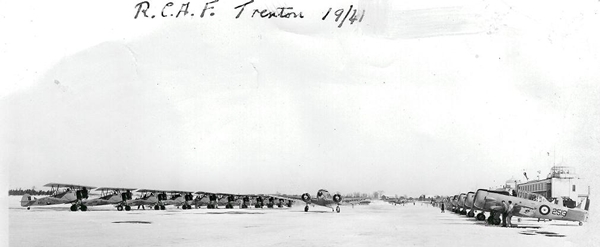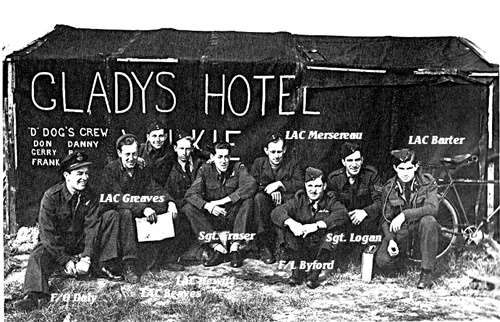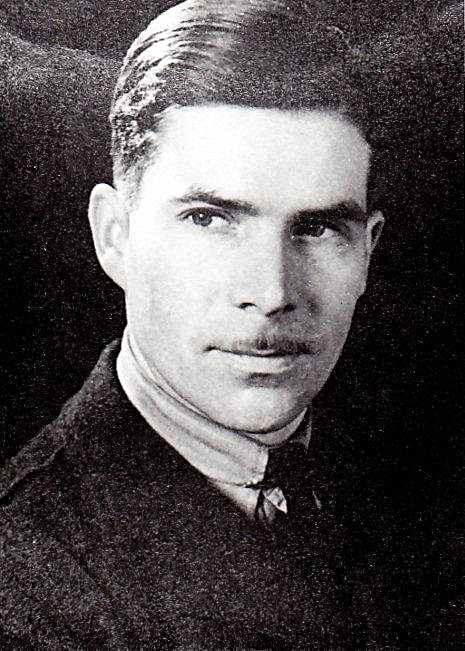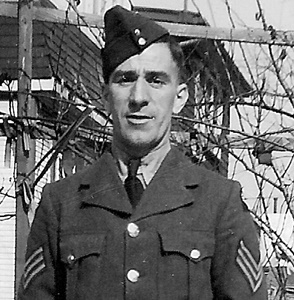Enlistment
Sgt. Daniel Logan, my father, first enlisted shortly after the declaration of war at a recruiting office on Jarvis
Street (Cawthra Square) in Toronto. The recruiter told him his age, which was 31, may go against him, had he already been with the RCAF that would be different.
Especially for aircrew duty which my dad had applied for.
He waited for a month without ever hearing back, the original recruitment office had been moved and many
applications for enlistment had been lost.
So he again filled out the enlistment forms this time lowering his age on the form. As it would happen the
interviewer was the same one he had the first time and he remembered my father and so persuaded him to apply for Airframe Mechanic rather than aircrew which he could
remuster later for aircrew.
Training Begins
Told to report to the Manning Depot No.1 which was located in the Exhibition grounds on the South end of Toronto was a welcome
surprise as it was only a short streetcar ride from where he resided. The government had gone to no expense to provide accommodations
for the increasing number of recruits posted to the Depot. The new arrivals were
each presented with a broom, shovel or bucket and brush to clean out one of the stalls in the Equine Building.
My dad said at least the horses had a better deal then the recruits, the horses were only one to a stall, the new arrivals
were four to a stall.
The good luck was not to last, a parade was called a few weeks after arriving the officers counted out a number of men
to step forward, to then collect their kit and report to the train station just North of the Exhibition grounds. Next stop No.2 Manning Depot
at Brandon Manitoba.

So it went from just a street car ride to reach home, to a long train trip to a part of Canada that he and many
of the other men had not ever seen before. My mother somehow managed to follow him out there along with a number
of other wives who pooled their money for accommodations and meals in a small boarding house near the base.
After six weeks a train again brought him back to Ontario, but my mother had to follow a little later as the
priority for travelers was higher for servicemen.
The large training center for all the trades was No.1 Technical Training School, located in St. Thomas, his
home for six months. Meanwhile things in Europe were getting worse; Hitler's troops had already rolled into France, Holland
and Belgium. The general feeling of the recruits was that they may never
get overseas and the fighting would end up being much closer to home. It was all up to the outcome of the Battle of Britain
taking part in the skies above England while my father was learning his trade.
These thoughts were not to deter the government and so the training for the future ground crews went lumbering
along as if the war would last forever.
The biggest challenge for all the trainees were the monthly exams, getting top scores was the best way for future promotions.
The courses covered a lot of different skills; airframes, aero engines, woodworking, machine shop, cable and rope splicing, soldering, welding and a number of other skills.
(Courses seem to be more general in nature then what would be normal later on in the war)
Many of the men felt that it would be hard to continue passing these monthly exams, in the end the few older men like my father who had some
work place experience in some of these fields found it much easier then their younger classmates. As good as the instructors were
being proficient in multiple skills was not possible for every trainee. This difference maybe could have led to the decision to revamp the
courses and concentrate on specific aspects of each trade.
Postings
The passing members of the class were split up into two groups, with one being posted to No. 8 SFTS in Moncton and
the rest including LAC Logan posted to No.1 CFS Trenton. Trenton was still in Ontario so driving home to Toronto on Leave was possible,
if they could get enough men to share thier ration coupons for gas to Toronto and more importantly back to base.
So no matter what the weather, when it was time for Leave all the Trades who were from that the Toronto
headed for one of dad's friends who had a "car" of sorts. Little or no brakes. Patched up tires and roof, patched up body work then
overloaded it with men, baggage and spare parts.
They would head off for Toronto or as close as the old thing would take them. Eventually dad found four tires
to replace the ones that were "liberated" from his old Chevy which was parked in a garage back on Banks Street.
Now he and the others had a source of safer transportation for their back and forth journey along the old the Kings Highway # 2.

Trenton was the show place of the RCAF.
Every type of aircraft flown would eventually show up there. It was while at Trenton he was given his first flight,
after he completed repairs on one of the aircraft. He was required to have the aircraft signed off. Jumping at the
chance to be airborne, the test pilot gave him the works, loop the loops, figure eights and inverted flying. Of course the pilot was having a ball,
swearing and cursing as if there was something wrong with the aircraft but after a while he broke into laughter.
For dad it must have been a glimpse at what he wanted to
be doing. His pay book shows many entries as eligible for flight pay.
Hagersville
The life at Trenton seemed to be more about "VIP Parades" then actual service work, although the varied experiences
of working on a range of different aircraft would later pay off. For now, it was not what he was looking for, he wanted to get to go overseas. He was offered
a post to a new SFTS with the understanding that it could lead to the overseas posting he wanted.
Promoted to Corporal and posted to No.16 SFTS at Hagersville, when he arrived the base was a bunch of empty
buildings, empty hangers and no supply of water.
The most important duty seemed to be guarding the limited water supply brought in each day. In a short time the
situation improved the base came alive quickly and he applied for testing for rank of Sergeant.
The main aircraft in use were a few Harvard's but mostly Ansons a twin engine trainer used as the first step
to multiple engine aircraft used by both Coastal Command and Bomber Command. Having passed the tests he found the
extra stripe became an asset for acquiring some of the scarce parts needed to keep the aircraft in serviceable condition.
There appeared to be a shortage of parts for the Ansons and reasons best known to some officer in the base HQ
the category "A" units were not being used for salvageable parts.

When he found that one of the Ansons that was being stripped of parts to repair others had only 30 hours flying
time on it, he stopped the robbing of parts and began to use the salvageable parts from the non-repairable Ansons. The unfortunate fact
of being at a flight training base was the loss of men from accidents and crash landings. This was reflected in his thoughts as he made
the notes that I am using. The fatal crashes, the funeral parades must have brought home to everyone the dangers and reality that surrounded
them even in this back water location far from the extreme dangers yet to come.
His transfer to an operational squadron overseas came through just as his project Anson finally came ready for
it's flight check out. His papers were delayed for two days until the Anson could be signed off by a test pilot and himself,
no one wanted to go up in the aircraft even though it was in better condition then the other basket cases being tested.
Going Overseas
On leave for a week back in Toronto, he informed my mother of his transfer overseas and his plans to apply for
aircrew as Flight Engineer, an aircrew position. Before leaving for Halifax he gave into my mother's wish not to apply
for aircrew and after an emotional farewell at the crowded Union Station
in Toronto, he was headed off for Nova Scotia. In the usual military way. The rush to get things moving proving
unnecessary as he and 2,000 other airmen ended up waiting two weeks in Halifax. Eeach night waiting and packed and ready in case called on
to march to some awaiting ship. Finally the notice came and as much of a secret a fashion as 2,000 men marching through the darkened streets of Halifax could be,
they found themselves on a dock facing the largest ship any of them had ever seen.
The ship he was to embark on was just discharging war brides, wounded soldiers and a large group of American soldiers who
were under arrest and on their way to US Military prisons when he arrived at the dock. Waiting on dock for six hours,
as he and the others stood in typical March Halifax weather. None of the officers gave an order
for the men to put their kit down, and slowly on their own they took their kit bags off their back and placed
them on the ground. Some Army Service Policeman started ordering them to pick them back up, but generally no one did.
The ship was completely painted over and was rumoured to be the Queen Mary, it wasn't until much later that
the secret was revealed that it was the newer and larger sister ship the Queen Elizabeth
Life on Board a Luxury Liner
Sgt. Logan was picked for Duty Watch, prior to the departure. This assignment would prove to have some
advantages. Even though he boarded on Wednesday night it was not until the following Monday that the ship departed.
His Duty Watch posting allowed him to go into areas not accessible others. From a vantage point in one of the gun
emplacements he observed train load after train load of troops arriving and being boarded. The uniforms of a wide range of nationalities
fresh from training camps across Canada packed the boat to well past it's civilian capacity limit.
The ships guns were one of the few open spaces available, but were under the control of US troops who very
strictly kept them off limits to all. This was made abundantly apparent by the menacing armed guards posted at each gun battery location.
One of the perks of being on Duty Watch was that Dad wore a Service Police arm band so the Americans in the gun positions allowed him access
and a vantage point to watch the parade of men and materials being loaded. By now the ship was almost wall to wall men.
Bunks in some areas were stacked twelve high. Being an NCO on Duty Watch he had a room with only eight others. Of course the room was only designed for four,
without huge kit bags taking up even more of the small cabin.
He had two memories that stood out before the departure of the ship. On Saturday night he watched as a convoy
of ships slipped out of Halifax harbour and out into the dark veil of the winter Atlantic. The next morning a number of the ships returned all
shot up and badly damaged, they had only been gone a day. A chilling picture of what was ahead for this troop ship on its voyage to Britain.
The other memory he wrote about was being assigned
to a detail to watch over a group of high ranking prisoners who were held in the ship's brig. They were not
to be talked to or to be mentioned to
anyone on board. Soon a contingent of RCMP officers took over the prisoners and no more was seen of them.
When the ship left port his Duty Watch responsibilities were now to be in charge of a crew of men who were to
manually close the water tight doors on a deck that was so far down in the ship it would have been impossible for anyone to escape from down there.
Getting to his meals was a challenge as the ship was so crowed he had to start almost an hour before his allotted meal time. Being on Duty
Watch did allow him to go to the head of the line but it was not much of perk. A Lifeboat drill was held but it
was plain to all that there was no
way to save even a small fraction of the men on board. The line-ups of men at the drill ran for hundreds of yards and
in places were ten men wide.
At one point while making the journey to his meals he noticed the distinct rays of daylight coming through one of
the port holes. One of the soldiers
on board had scraped the black paint off the porthole glass at some point in the voyage. When he attempted to
bring it to an officers attention he
was told to "bugger off" by an Army Lieutenant. So Sgt. Logan went to the ship's Duty Officer and reported what
had happened. The Duty Officer
said he would take care of it and advised my dad it might not be good idea to go back through that part of the
ship on his own again after the naval officer "talked" to the culprits.
With the ship in range of air bourne protection, some of the tension of the passage seemed to disappear and now
all anyone wanted was to be off the ship.
Departing the large ship at Greenock was done by ferrying everyone off by smaller craft which took a very long time. For dad it was a heart breaking
moment, being only 20 miles from his mother's home, which he had left fourteen years earlier.
Just before the war broke he had attempted to get his mother and sister
to Canada. Arrangements had been made
for their passage to Canada but my grandmother who had a strange sense of future dangers
refused to not go on "that" ship. On September 3rd, 1939 "that" ship, the S.S. Athenia was sunk by a U-Boat
Life Overseas

As with all RCAF personnel Sgt. Logan was sent by train to Bournemouth. Bournemouth was a lesson for all new
arriving Canadians, the war became all the closer with France within sight and the odd Luftwaffe attack,
rationing, blackouts, Fire Watches, air raid alerts. But mostly the rationing. The excellent meals on board the ship
were now a thing of the past. Everyone was posted to commandeered homes stripped of furniture and full of bunks, but all the eating was at the
hotels using ration cards.
After a very short time there his posting came in. The selection of posting was announced was not what he was first told. He was to ship out with some squadron headed for the Near East.
Which seemed to him to be an adventure itself and a chance to see the territory his father had served in some 50 years earlier.
The posting turned out to be an error and he received the proper orders just before he was to ship out the land of deserts. Now firmly with 419 he started work on the squadron's Halifax bombers.

While he was in the makeshift dispersal hut hunting for a part for a newly arrived Halifax, a loud bang sounded outside
and something hit the hut very hard. When he got outside the Halifax was sitting on an angle from a punctured tire. At first he thought
that was all that had happened. He then noticed the blackened area in the concrete pad under the bomb doors, as well as small holes in the fuselage under side.
What really shook him up was the two ragged holes in the port engine nacelle where he had been working shortly before.
An investigation followed of which the results were never released. But the word spread around the Base that a small practice bomb had been hung up in the bomb racks and had just decided to fall out. The bomb had contained a "Flash" filling used on night time bombing practice. The aircraft was cordoned off for a while, according to what my father said, every RCAF officer in the area came for a look.
Other mishaps
There was an incident of Halifax crashing on take off at Middleton St. George. The bomb laden aircraft was out of control while still on the main runway
before it exploded on impact after the under carriage collapsed. My father and his Flight Sergeant were in trucks travelling back to the dispersal pad when it happened.
My father described the effects of the blast as pulling the skin on his face back tightly and jarring the truck
he was in with great force. The blast in fact tore the canvas cover off the rear of that truck. But what shocked him next was the truck ahead of his with
Flight Sergeant Sinclair riding in it had been completely thrown over. He and the WAAF driver were running to help F/S Sinclair and his driver when they saw them
get out apparently unharmed. Everyone was coming from every direction to help those in the crashed aircraft. ( The crew all from another squadron were all lost in the crash.)

It was not until my father's passing that I met up again with Fred Sinclair, his former F/S and life time friend that I learned about this
episode with the trucks.
Fred Sinclair also told me about the incident with friendly fire. The first one which was being fired on by one of his
own crew's gunners who had fired off the quadruple tail gun for testing; with out sectioning off the area or obtaining permission to fire the gun.
On another occasion during a checkout flight after
a series of repairs. The aircraft was completing a wide circuit and returning back to base when an anti-aircraft battery opened up
on them and kept firing while the aircraft's wireless operator and navigator were showing the colours for the day.
They completely missed the Lancaster even though it was flying low and fairly slow.
Sometimes your father, grandfather or whoever was serving overseas will not mention these moments, thought best left to be forgotten. Family history is something to remember and cherish, ones its gone it is gone forever.

As far as I could find during my research, KB738 VR-D nick named "Dorothy" was the one Lancaster that was lost he lost. As the NCO in charge, he met with many of the crew members over the years. And most certainly knew F/O Fred How (sometimes shoan as Howe) himself and the Flight Engineer Sgt. Joe Atkinson. Every time any crew flew one of VR-D Lancasters they would have to sign in and out the aircraft for the night with Sgt. Logan.
The ground crews would be there every time the bombers took off on their dangerous operations. Not by orders but because they deeply cared about those men who flew off each night. They would also be there watching as each aircraft returned. They would stand there waiting long after the last one landed hoping those missing were only late.
The feeling of loss was not something that went away with the passing of time. My father had nightmares, right up until his passing that were obviously related to the loss of the crew of "Dorothy" as well as the other crews he knew.
The Story of "Dorothy" shown above
Peace is declared posting to 433 "Tiger" squadron
The 419 Squadron had almost totally wound down combat operations and ground crews were preparing to get ready their Lancasters
ready for the long trip back to Canada.
Dad wanted to go back on one of the Lancasters but missed out on the draw for a place on board. He had put in for "Tiger Force" ( the RCAF .... in the war in the Pacific, the next thing he knew he was posted to "Tiger" squadron ?
At first he found it confusing but since they were acting as an occupation squadron and still flying, it gave
him the opportunity to fly on a number of observation flights over France and Germany. He was finally getting his aircrew request filled
even if it was as an unofficial observer. From this he saw first-hand what he called the unbelievable destruction of the European cities.
Time to go home
At last he was posted to Torquay for a short rest stop before boarding a cramped train heading for Liverpool and cramped ship
for home. The ship took them all the way to Quebec city where the men of all the services boarded trains bound for all over Canada. For many it was
the end of the war and their service to Canada. For some such as my dad it was just a thirty day leave before heading to Nova Scotia and
preparations for Pacific operations as part of Tiger Force. Before the 30 days were up the United States had ended the war in the Pacific and Dad
received his Discharge papers in the mail. And it was back to civilian life.








